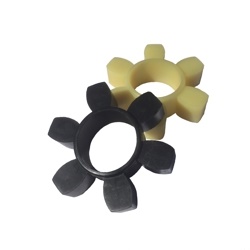HRC Hub
Are you looking for reliable, high-performance power transmission solutions for your industrial machinery? Look no further than our range of HRC hubs and couplings! As a trusted division of Naismith Engineering & Manufacturing Co Pty Ltd, with over 75 years of experience in the power transmission industry, we offer top-quality HRC coupling products to meet all your mechanical needs.
Read More
HRC Coupling
HRC coupling, which stands for Highly Resilient Coupling, is a type of flexible coupling designed to transmit torque while accommodating misalignment between shafts. These couplings are known for their excellent performance in demanding industrial applications.
Key features of HRC coupling include:
- High Torque Capacity: HRC couplings can handle significant torque loads, making them suitable for heavy-duty applications.
- Misalignment Tolerance: These couplings can accommodate angular, parallel, and axial misalignment between connected shafts.
- Vibration Dampening: The flexible element in HRC couplings helps absorb shock and reduce vibration transmission.
- Easy Installation and Maintenance: The hub-and-sleeve design allows for easy assembly and disassembly without moving connected equipment.
- Fail-Safe Operation: In case of element failure, HRC couplings can continue to operate for a short period, preventing immediate system shutdown.
- Wide Range of Sizes: Available in various sizes to suit different shaft diameters and torque requirements.
- Taper Lock or Keyway Options: HRC hubs can be fitted with either taper lock bushings or keyways for secure shaft attachment.
Our range of HRC coupling products includes:
- HRC Hubs: The core component of the coupling, available in different sizes and configurations.
- Flexible Elements: High-quality rubber elements that provide the coupling's flexibility and vibration dampening properties.
- Taper Lock Bushings: For secure, adjustable attachment of hubs to shafts
Whether you need a complete HRC coupling assembly or individual components like HRC hubs, our extensive inventory has you covered.
Why Choose Our Products?
When it comes to HRC coupling and HRC hub solutions, we stand out as the premier choice for businesses across Australia. Here's why:
- Quality Assurance: Quality has always been our watchword. Each product undergoes rigorous checks to ensure it meets our high standards.
- Extensive Inventory: With over 30,000 stock items in our 2,400 square metre Melbourne warehouse, you're sure to find the HRC components you need.
- Global Sourcing: We import from 23 trusted suppliers across 9 different countries, providing access to a wide range of high-quality products at competitive prices.
- Same-Day Dispatch: Most orders are sent out on the day they're placed, ensuring you receive your HRC coupling components as quickly as possible.
- Free Delivery: All orders over $75 qualify for free delivery, adding even more value to your purchase.
- Expert Advice: Our team has decades of experience in mechanical power transmission. We're here to help you find the right HRC coupling solutions for your needs.
- Competitive Pricing: Our global sourcing capabilities and efficient operations allow us to offer high-quality products at competitive prices.
- Custom Solutions: Can't find exactly what you need? We can work with you to create custom HRC coupling solutions tailored to your specific requirements.
- Australian Owned and Operated: As a division of Naismith Engineering & Manufacturing Co Pty Ltd, we've been serving Australian industries since 1947.
- Comprehensive Product Information: Each product listing on our website includes detailed specifications, making it easy to choose the right HRC components for your needs.
Need Help?
Choosing the right HRC coupling or HRC hub for your application can be challenging, but you don't have to go it alone. Our team of experienced professionals is here to help you every step of the way. With decades of experience in the power transmission industry, we can provide invaluable advice on selecting the right components, proper installation techniques, and maintenance best practices.
Whether you're looking for a standard HRC coupling for a common application or need a custom solution for a unique machinery setup, our extensive inventory and global sourcing capabilities ensure that the right product is always at your fingertips. The 2,400 square metre Melbourne warehouse houses over 30,000 stock items, allowing for quick turnaround times and same-day dispatch for most orders.
FAQs
What is an HRC coupling used for?
HRC couplings are used to connect two shafts for the purpose of transmitting power. They are particularly useful in applications where there may be misalignment between the shafts or where vibration dampening is required. Common applications include pumps, compressors, and various industrial machinery.
How do I choose the right size HRC coupling?
Selecting the right size HRC coupling depends on several factors:
- The shaft diameters to be connected
- The torque to be transmitted
- The operating speed
- The degree of misalignment to be accommodated Our team can help you calculate the appropriate size based on these factors.
Are HRC hubs interchangeable between different brands?
While HRC hubs are designed to a standard, there can be slight variations in hubs between brands. It's generally best to use components from the same manufacturer to ensure proper fit and performance. If you need to replace a component, contact us for advice on compatibility.
How often should HRC couplings be maintained?
The maintenance interval for HRC couplings depends on the application and operating conditions. Generally, it's recommended to inspect the coupling regularly for signs of wear or damage, particularly the flexible element. Our team can provide specific maintenance recommendations based on your usage.
Can HRC couplings be used in high-temperature environments?
Standard HRC couplings are suitable for moderate temperature ranges. For high-temperature applications, special heat-resistant flexible elements are available. Contact our team to discuss your specific temperature requirements.




